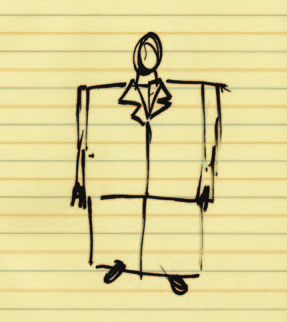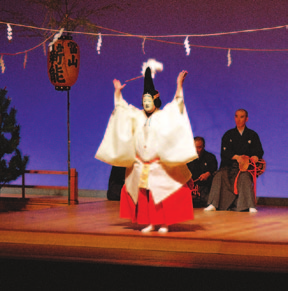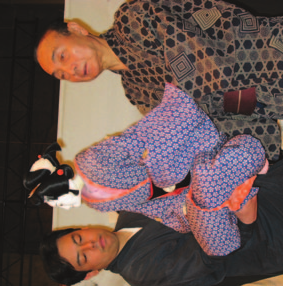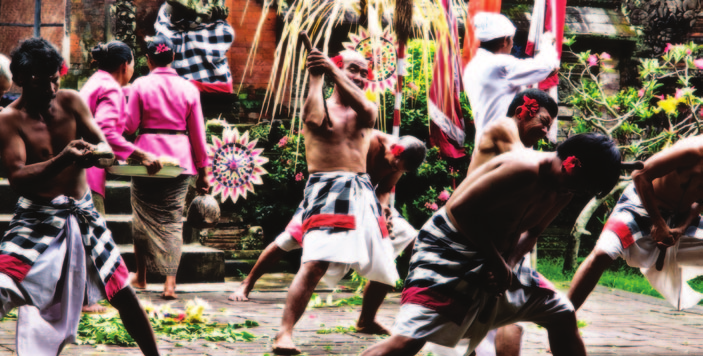How Music Works (9 page)
Authors: David Byrne
Tags: #Science, #History, #Non-Fiction, #Music, #Art

of us grooving on stage, made actual dancing as opposed to thrashing about
sort of okay. I got the sense that what was new was not just having black and white folks together on stage—there was nothing new about that—but the
way in which we did it. Our shows presented everyone as being part of the
band. Everyone played together; that was what was new.
My own contorting on stage was spontaneous. I obviously had to be at the
mic when I was singing, but otherwise the groove took me and I let it do what it wanted. I had no interest in or ability to learn smooth dance moves, though we all watched
Soul Train
. Besides, a white nerdy guy trying to be smooth and black is a terrible thing to behold. I let my body discover, little by little, its own grammar of movement—often jerky, spastic, and strangely formal.
The tour eventually took us to Japan, where I went to see their tradi-
tional theater forms: Kabuki, Noh, and Bunraku. These were, compared to
Western theater, highly stylized;
presentational
is the word that is sometimes used, as opposed to the pseudo-naturalistic theater we in the West
are more used to.F
Everyone wore massive, elaborate costumes and moved in ways that were
unlike the ways people move in real life. They may have been playing the parts of noblemen, geishas, or samurai, but their faces were painted and they spoke in voices that were far from natural. In Bunraku, the puppet theater, often a whole group of assistants would be on stage operating the almost-life-size
puppet. We weren’t supposed to “see” them, but they were right there, albeit dressed in black.G The text, the voices, would come from a group of guys
seated off to the side. The character had in effect been so fragmented that
the words they spoke didn’t come from close to or even behind that puppet,
but from other performers on an entirely different part of the stage. It was as if the various parts of an actor’s performance had been deconstructed, split into countless constituent parts and functions. You had to reassemble the
character in your head.
Was any of this applicable to a pop-music performance? I didn’t know, but
over dinner in Tokyo one night the fashion designer Jurgen Lehl offered the old 50 | HOW MUSIC WORKS



adage that “everything on stage needs
to be bigger.” Inspired, I doodled an
idea for a stage outfit. A business suit
(again!), but bigger, and stylized in the
manner of a Noh costume. This wasn’t
exactly what he meant; he meant ges-
ture, expression, voice. But I applied it
to clothing as well.H
On a break from the tour, I went
south to Bali, a place the choreogra-
pher Toni Basil, whom Eno and I had
F
met during the
Bush of Ghosts
sessions,
had recommended as being transport-
ing and all about performance. I rented
a small motorcycle and headed up into
the hills, away from the beach resorts. I
soon discovered that if one saw offer-
ings of flowers and fruit being brought
to a village temple compound in the
afternoon, one could be pretty certain
that some sort of ritual performance
would follow there at night.
Sure enough, night after night I
would catch dances accompanied by
gamelan orchestras and shadow-pup-
G
pet excerpts from the Hindu Rama-
H
yana—epic and sometimes ritual
performances that blended religious
and theatrical elements. (A gamelan
is a small orchestra made up mainly
of tuned metallic gongs and xylo-
phone-like instruments—the interplay
between the parts is beautiful and
intricate.) In these latter events some
participants would often fall into a
trance, but even in trance there were
DAV I D BY R N E | 51

prescribed procedures. It wasn’t all thrashing chaos, as a Westerner might
expect, but a deeper kind of dance.I
As in Japanese theater, the performers often wore masks and extreme
makeup; their movements, too, were stylized and “unnatural.” It began to sink in that this kind of “presentational” theater had more in common with certain kinds of pop-music performance than traditional Western theater did.
I was struck by other seemingly peripheral aspects of these performances.
The audiences, mostly local villagers of all ages, weren’t paying attention half the time. People would wander in and out, go get a snack from a cart or leave to smoke a bidi cigarette, and then return to watch some more. This was more like the behavior of audiences in music clubs than in Western theaters, where they were expected to sit quietly and only leave or converse once the show
was over.
These Balinese “shows” were completely integrated into people’s daily lives, or so it seemed to me. There was no attempt to formally separate the ritual and the show from the audience. Everything seemed to flow into everything else.
The food, the music, and the dance were all just another part of daily activity.
I remembered a story about John Cage, who, when in Japan, asked someone
what their religion was. The reply was that they didn’t have a strict religion—
they danced. Japanese do, of course, have Buddhist and Shinto rituals for weddings, funerals, and marriages, but a weekly thing like going to church or temple doesn’t exist. The “religion” is so integrated into the culture that it appears in
I
52 | HOW MUSIC WORKS
daily gesture and routines, unsegregated from ordinary life. I was beginning to see that theatricality wasn’t necessarily a bad thing. It was part of life in much of the world, and not necessarily phony either.
I guess I was primed to receive this new way of looking at performance,
but I quickly absorbed that it was all right to make a show that didn’t pretend to be “natural.” The Western emphasis on pseudo-naturalism and the cult of
spontaneity as a kind of authenticity was only one way of doing things on
stage. I decided that maybe it was okay to wear costumes and put on a show.
It didn’t imply insincerity at all; in fact, this kind of practiced performance was all around, if one only looked at it. The services in a gospel church are funky and energetic, but they are prescribed and happen in almost identical
sequences over and over. That doesn’t make them any less real or less power-
ful. In the world of the ecstatic church, religion bleeds into performance, and there are obvious musical parallels with what we were doing.
In Los Angeles I collaborated with Toni to make a music video for a cou-
ple of the songs from
Remain in Light
. For “Once in a Lifetime,” I worked out an elaborate dance routine that borrowed from Japanese street dance, gospel
trance, and some of my own improvisations. Toni had worked with untrained
dancers before, so she knew how to get me to make my improvised moves,
edit them, select the best ones, refine them further, and begin to order them into a sequence. It took weeks to get the moves tight. It was all going to be filmed in one master shot, so I had to be able to perform the whole thing from top to bottom without stopping on multiple takes. It was a song-and-dance
routine, as she described it, though nothing like what one normally thinks of when one hears that phrase.
We added little film snippets during the editing that revealed the source
material for some of the moves: a few seconds of a kid dancing in Yoyogi
Park in Tokyo (dancing there is now forbidden!) and a few frames from an
anthropological film about African dance, with the dancers crouching near the ground. I wanted to show my sources, not claim I invented everything, though my jerky improv versions weren’t much like the originals in any case.
Talking Heads recorded another record,
Speaking in Tongues
, that was made using a very similar process to
Remain in Light
, though this time without Eno’s involvement. In thinking of what kind of performance and tour
would follow, I decided to apply my insights from Japan, Bali, and the gospel church. This show would be mapped out from beginning to end.
DAV I D BY R N E | 53

In retrospect, the earlier tour with a big band had been a work in pro-
gress. My movements during rehearsals gradually became more formal as I
realized which improvisations worked in which sections of which songs. It
was a kind of organic choreography, like what I’d done on the video, but now involving more people and for a whole show. I storyboarded the whole thing,
sometimes not knowing which song would go with which staging idea. The
songs got assigned to the staging and lighting ideas later, as did details of the movements.J
We decided that we’d all wear neutral gray outfits this time. I had realized that people on stage can either stick out (if they wear white or sparkly outfits) or disappear (if they wear dark colors). With music shows, there is inevitably so much gear on stage—guitars, drums, keyboards, amps—that sometimes
